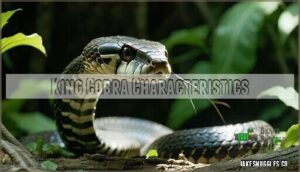This site is supported by our readers. We may earn a commission, at no cost to you, if you purchase through links.

These massive constrictors dominate different habitats – reticulated pythons rule Southeast Asian forests while green anacondas reign in South American wetlands.
The Burmese python, another heavyweight contender, can stretch over 20 feet and has become an invasive powerhouse in Florida’s Everglades.
These serpentine titans showcase nature’s incredible ability to produce predators of extraordinary proportions, each perfectly adapted to their environment with unique hunting strategies and remarkable physical capabilities that separate them from ordinary snakes.
Table Of Contents
- Key Takeaways
- Largest Snake Breeds
- Longest Venomous Snakes
- Giant Constrictors
- Extinct Giant Snakes
- Snake Geographic Distribution
- Frequently Asked Questions (FAQs)
- What is the biggest breed of snake in the world?
- Who is bigger, king cobra or python?
- Is anaconda bigger than titanoboa?
- What is the top 10 longest snake in the world?
- Is there a 30 foot snake?
- What is the largest snake in the world?
- What is the largest snake in South Asia?
- What is the largest snake in Africa?
- What is the heaviest venomous snake?
- What is the largest snake in Australia?
- Conclusion
Key Takeaways
- You’ll find the reticulated python holds the world record as the longest snake, stretching over 30 feet through Southeast Asian forests with incredible swimming abilities that help them spread across islands.
- You’ll discover green anacondas reign as the heaviest snakes at up to 550 pounds, with females dramatically outweighing males in South America’s wetlands where pristine habitats produce the largest specimens.
- You’ll encounter Burmese pythons as invasive giants in Florida’s Everglades, where escaped pets have established breeding populations that devastate native wildlife through their powerful constricting abilities.
- You’ll learn that prehistoric giants like Titanoboa dwarfed today’s largest snakes at 42 feet long and 2,500 pounds, ruling ancient rainforests until global cooling eliminated their warm environments 60 million years ago.
Largest Snake Breeds
You’ll encounter some of the most incredible serpents on Earth when exploring the world’s largest snake breeds.
Nature’s most magnificent serpents await discovery in the world’s giant snake species.
These massive reptiles include the record-breaking Reticulated Python that can stretch over 30 feet long, the heavyweight Green Anaconda that tips the scales at over 500 pounds, and the invasive Burmese Python that’s made Florida its new home.
Reticulated Python Characteristics
You’ll encounter the reticulated python, one of the largest snake breeds and longest snake species on Earth.
These giant snake species showcase distinctive reticulated length reaching over 20 feet, with stunning scalation patterns featuring diamond-shaped blotches in gold, black, and white.
Their temperament varies greatly – wild specimens are defensive, while captive care programs have produced calmer individuals.
Conservation status remains stable despite habitat pressures.
These snakes are also known to be excellent swimmers, which aids in their dispersal across islands.
Green Anaconda Size and Weight
You’ll discover that female green anacondas dwarf their male counterparts through extreme sexual dimorphism.
These heaviest snakes can reach 550 pounds and stretch over 29 feet, making them the biggest snakes by mass.
Habitat impact directly influences anaconda weight and length—pristine Amazon wetlands produce the largest specimens.
Their conservation status remains stable, though habitat destruction threatens maximum size potential in affected regions.
They’re primarily found in the Amazon and Orinoco basins.
Burmese Python Habitat and Distribution
You’ll find Burmese pythons thriving in their native Southeast Asian habitats, from Myanmar to Vietnam.
However, these biggest snakes have created a Florida invasion crisis, where escaped pets established breeding populations.
This conservation status nightmare demonstrates how python ecology disrupts local ecosystems.
Their diet impact devastates native wildlife, making these nonvenomous snakes a serious environmental threat requiring immediate control measures.
Longest Venomous Snakes
While constrictors get most of the attention, you’ll find that venomous snakes can reach impressive lengths too.
The king cobra stands out as the world’s longest venomous snake, stretching up to 18 feet and commanding respect across Asian forests.
King Cobra Characteristics
King cobras consistently rank as the world’s longest venomous snakes, reaching impressive lengths up to 18 feet.
You’ll recognize these serpents by their distinctive characteristics:
- Venom Potency – Delivers neurotoxic venom through fixed fangs
- Scale Patterns – Smooth scales with distinctive banding
- Hood Display – Iconic neck flaring when threatened
- Reproductive Behavior – Builds elaborate nests for eggs
- Lifespan – Lives 15-20 years in captivity
Their king cobra length surpasses most venomous snake size records, making snake size comparison studies fascinating for researchers studying snake breed facts.
Some researchers even study the properties of their venom.
King Cobra Habitat and Distribution
You’ll find these massive venomous serpents across tropical Asia’s Forest Ecosystems, from India to Indonesia.
Their Geographic Range spans dense jungles where Climate Influence creates perfect hunting conditions, though Human Impact threatens their Conservation Status.
They thrive in specific king cobra environments.
| Region | Countries | Habitat Type |
|---|---|---|
| South Asia | India, Sri Lanka, Bangladesh | Dense forests, bamboo thickets |
| Southeast Asia | Thailand, Malaysia, Myanmar | Tropical rainforests, mangroves |
| East Asia | Southern China, Philippines | Mountain forests, coastal areas |
| Island Nations | Indonesia, Brunei | Primary forests, agricultural edges |
These king cobra length records show impressive snake size comparison data, making venomous snake size charts essential for understanding reptile size charts and snake breed facts.
King Cobra Diet and Hunting Habits
The king cobra’s diet focuses exclusively on other snakes, earning its reputation as the ultimate serpent predator.
You’ll witness nature’s most strategic hunter employing sophisticated techniques that make python vs anaconda debates seem simple.
Key Hunting Strategies:
- Prey Selection – Targets venomous and non-venomous snakes up to 10 feet long
- Venom Potency – Delivers neurotoxins causing respiratory failure within minutes
- Hunting Strategies – Uses stealth, speed, and precise striking accuracy
- Digestion Process – Swallows prey whole, digesting over several days
- Juvenile Diet – Young cobras start with smaller snake species and lizards
Other Longest Venomous Snakes
Beyond the king cobra, you’ll encounter several venomous giants that pack serious punches.
The black mamba stretches up to 14.8 feet and strikes with lightning speed, delivering potent neurotoxins through razor-sharp snake fangs.
South American bushmasters reach 12 feet, wielding complex venom cocktails containing both neurotoxins and hemotoxins.
Forest cobras climb to nearly 10 feet in African woodlands, while coastal taipans deliver some of nature’s most toxic venom.
Thankfully, snake antivenom exists for most species.
Giant Constrictors
When you think about giant constrictors, you’re looking at nature’s most impressive squeeze machines.
These massive snakes include the reticulated python, green anaconda, and Burmese python – each one capable of taking down prey much larger than themselves through sheer crushing power.
They are examples of giant constrictors that can exert immense force to immobilize their prey.
Reticulated Python Size and Habitat
You’ll discover that reticulated python size reaches record-breaking lengths up to 33 feet, making them the world’s longest snakes.
Their habitat range spans Southeast Asian rainforests, from Myanmar to Indonesia. These constrictor snakes adapt to diverse environments including grasslands and urban areas.
Python length varies substantially, with females typically larger than males. Their conservation status remains stable despite habitat pressures from deforestation and human expansion.
They can even display a surprisingly docile temperament with consistent gentle handling.
Green Anaconda Size and Habitat
Massive size makes green anacondas nature’s heavyweight champions.
You’ll find these colossal constrictors dominating South American wetlands, where their green anaconda weight can exceed 227 kilograms.
Their impressive size helps debunk common anaconda myths about these gentle giants.
- Muddy riverbanks where anacondas bask like living logs
- Shallow waters concealing 20-foot serpentine shadows
- Dense vegetation providing perfect camouflage for hunting
- Flooded forests echoing with splashing prey sounds
- Remote swamplands where few humans dare venture
Burmese Python Size and Habitat
You’ll find Burmese pythons reaching impressive lengths of 16-23 feet, with some snake record sizes exceeding these measurements in Florida Everglades populations.
Their python diet includes mammals, birds, and reptiles, making conservation efforts essential for protecting native wildlife from these powerful constrictors.
These invasive species have adapted remarkably well to their new environment, where python growth often surpasses their native Southeast Asian habitat rates, posing a significant threat to the native wildlife due to their powerful constrictors nature and ability to thrive in the Florida Everglades.
Extinct Giant Snakes
You’ll be amazed by the prehistoric giants that once ruled ancient ecosystems millions of years ago.
These extinct serpents make today’s largest snakes look small, with some reaching lengths that would stretch across multiple school buses.
Titanoboa Cerrejonensis Size and Habitat
You’ll be amazed by Titanoboa cerrejonensis, the ultimate snake record holder.
This prehistoric monster dwarfed today’s giants, ruling ancient rainforests with unmatched size and power.
This prehistoric giant ruled Colombia’s Cerrejon rainforests 60 million years ago when paleoclimate conditions supported massive reptiles.
Here’s what made this extinct boa constrictor special:
- Titanoboa size: 42 feet long, weighing 2,500 pounds
- Cerrejon habitat: Dense tropical swamps with crocodile prey
- Extinction causes: Global cooling eliminated their warm environment
Unlike today’s african rock python or yellow anaconda, Titanoboa’s modern relatives seem tiny by comparison.
Gigantophis Garstini Size and Habitat
You’ll discover Gigantophis garstini through fossil evidence from Egypt’s Fayum region, dating back 40-35 million years.
This ancient ecosystem supported massive constrictors rivaling today’s african rock python and boa constrictor size.
Extinction theories suggest climate shifts ended their reign.
Unlike yellow anaconda habitat preferences, Gigantophis thrived in tropical floodplains with evolutionary context linking them to Madagascar’s extinct giants.
Palaeophis Colossaeus Size and Habitat
You’ll encounter Palaeophis Colossaeus reaching impressive dimensions of up to 30 feet in prehistoric marine environments.
This extinct giant inhabited warm, shallow seas across North Africa and Europe during the Eocene epoch.
Fossil discoveries reveal its massive boa constrictor size proportions, showcasing evolutionary history that ended due to climate changes.
The magnitude of these ancient serpents demonstrates how environmental shifts can determine survival, making their extinction causes a fascinating study in prehistoric adaptation.
Vasuki Indicus Size and Habitat
You’ll discover Vasuki indicus ranks among history’s most colossal serpents, stretching up to 50 feet through ancient Indian swamplands.
This Middle Eocene giant inhabited warm, humid coastal marshes 47 million years ago, where fossil discoveries reveal its massive vertebrae and evolutionary history within diverse ancient ecosystems.
Understanding their habitat requires mapping snake distribution patterns.
- Vasuki Size: Reached 36-50 feet long, weighing up to 2,200 pounds
- Vasuki Habitat: Lived in tropical swamps and coastal marshlands in western India
- Fossil Discoveries: 27 vertebrae found in Kutch region provide detailed anatomical data
- Ancient Ecosystems: Shared environment with primitive whales, crocodiles, and giant catfish
Snake Geographic Distribution
You’ll find the world’s largest snakes scattered across four main continents, each region hosting its own impressive giants.
From South America’s massive anacondas to Southeast Asia’s record-breaking pythons, these serpents have adapted to thrive in their specific geographic territories.
South American Snake Species
South America’s Amazon basin hosts the world’s heaviest snake, the Green Anaconda, thriving in wetland Anaconda Habitat.
You’ll find massive Boa Constrictors alongside various Amazon Snakes throughout tropical regions.
While Venomous Snakes exist here, constrictors dominate size records.
Snake Conservation efforts protect these giants as language barriers challenge research across diverse cultural differences in remote areas.
Southeast Asian Snake Species
When exploring Southeast Asia’s snake diversity, you’ll find the reticulated python reigning as the world’s longest serpent.
These Island Endemics showcase remarkable language variation in local folklore across different cultures.
Human Impact threatens many species’ Conservation Status, while Snake Venom research reveals fascinating language nuances in traditional healing practices.
Language learning about regional species helps conservation efforts flourish.
African Snake Species
Africa’s snake diversity showcases remarkable language preferences in species naming.
The massive African Rock Python dominates with impressive size, while deadly Puff Adder and various Mamba Varieties display unique language nuances in their classifications.
Boomslang Venom represents fascinating language variation in toxicology terms.
Meanwhile, the harmless Egg-Eating Snake demonstrates language learning through its specialized feeding behavior, reflecting Africa’s incredible language diversity, including remarkable language preferences, unique language nuances, and incredible language diversity.
Australian Snake Species
Australia’s snake diversity showcases remarkable language preferences in how different species communicate through chemical signals and body positioning.
You’ll find these impressive serpents across the continent’s varied landscapes:
- Coastal Taipans reach 10 feet and inhabit northern regions
- Inland Taipan delivers the world’s most potent venom
- Mulga Snake spans nearly 10 feet across multiple habitats
- Death Adders use unique tail-luring hunting techniques
- Tiger Snakes display distinctive banding patterns
This language diversity in behavioral communication reflects millions of years of evolutionary language learning.
These snakes thrive across diverse areas, from freshwater to marine environments, showcasing their ability to adapt to various ecosystems and evolutionary language learning.
Frequently Asked Questions (FAQs)
What is the biggest breed of snake in the world?
The Reticulated Python takes the crown as the world’s longest snake, stretching up to 33 feet. You’ll find these impressive reptiles slithering through Southeast Asia’s forests and swamps.
Who is bigger, king cobra or python?
Pythons are generally much larger than king cobras. You’ll find that reticulated pythons can reach 30 feet, while king cobras max out around 18 feet, making pythons the clear winner.
Is anaconda bigger than titanoboa?
Like comparing a modern sports car to a fossilized dinosaur, you’re contrasting living anacondas with extinct titanoboas.
Today’s green anacondas reach about 30 feet, while prehistoric titanoboas stretched an incredible 40-50 feet long.
What is the top 10 longest snake in the world?
You’ll find the reticulated python leads as the world’s longest, reaching 33 feet.
Green anacondas, Burmese pythons, African rock pythons, and Indian pythons follow, with ball pythons and boa constrictors completing the impressive lineup, including the reticulated python.
Is there a 30 foot snake?
Back in Shakespeare’s time, you’d definitely want to keep clear of 30-foot serpents.
Yes, reticulated pythons can reach 30 feet long, making them the world’s longest snakes.
They’re Southeast Asian giants you’ll respect from afar.
What is the largest snake in the world?
The reticulated python holds the title as the world’s longest snake, reaching lengths up to 33 feet. You’ll find these massive constrictors in Southeast Asia’s tropical forests and wetlands.
What is the largest snake in South Asia?
The Indian Python dominates South Asia as the region’s largest snake species. You’ll find these impressive constrictors reaching lengths up to 20 feet, making them formidable predators across their native range.
What is the largest snake in Africa?
Looking at a 20-foot shipping container, you’d need Africa’s longest serpent to match its length.
The African Rock Python (Python sebae) dominates as Africa’s largest snake, reaching impressive lengths up to 20 feet and weighing over 200 pounds, making it a 20-foot long specimen that is also very heavy.
What is the heaviest venomous snake?
You’ll discover the eastern diamondback rattlesnake takes the title as heaviest venomous snake, weighing up to 34 pounds and reaching over seven feet long in southeastern USA waters.
What is the largest snake in Australia?
Australia’s massive carpet python claims the title as your continent’s largest snake species.
You’ll find these impressive constrictors stretching up to 4 meters long, dominating the eastern regions with their powerful, muscular builds.
Conclusion
Remarkably, the largest snake breeds in the world represent nature’s most magnificent predators, showcasing evolutionary perfection across millions of years.
You’ve explored how reticulated pythons claim length records, green anacondas dominate weight categories, and Burmese pythons thrive as invasive species.
These serpentine giants demonstrate incredible adaptability across diverse habitats from Southeast Asian rainforests to South American wetlands.
Whether you’re fascinated by modern constrictors or extinct titans like Titanoboa, these remarkable species continue to captivate researchers and enthusiasts worldwide with their extraordinary size and hunting capabilities.
- https://www.nhm.ac.uk/discover/what-is-the-biggest-snake-in-the-world.html
- https://www.dimensions.com/element/reticulated-python-malayopython-reticulatus
- https://www.petmd.com/reptile/species/reticulated-python
- https://a-z-animals.com/animals/reticulated-python/
- https://myfwc.com/wildlifehabitats/profiles/reptiles/snakes/reticulated-python/
















